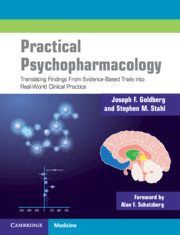 Practical Psychopharmacology
Practical Psychopharmacology from Part II - Targets of Pharmacotherapy
Published online by Cambridge University Press: 19 October 2021
Trauma and dissociation are together often thought of as falling more within the treatment realm of cognitive-behavioral psychotherapy than psychopharmacology. Indeed, in the case of PTSD, trauma-focused psychotherapies collectively exert larger effect sizes than seen with pharmacotherapies (Watts et al., 2013; Lee et al., 2016), which in the aggregate yield response rates only of about 20–30%. Yet, in order to understand the potential relevance of pharmacotherapy to psychological trauma, one must first appreciate the interplay between trauma’s psychological and neurobiological corollaries. Traumatic events form durable, emotionally based memories consolidated through limbic circuitry – in turn affecting emotional regulation and broad cognitive domains (attentional processing and vigilance, executive function, and impulse control). Environmental cues that become associated with threats to one’s physical and/or emotional well-being become aversive and can elicit fear responses, involving autonomic hyperarousal and vigilance, and can prompt intrusive, repetitive thought patterns laced with negative affect states.
To save this book to your Kindle, first ensure [email protected] is added to your Approved Personal Document E-mail List under your Personal Document Settings on the Manage Your Content and Devices page of your Amazon account. Then enter the ‘name’ part of your Kindle email address below. Find out more about saving to your Kindle.
Note you can select to save to either the @free.kindle.com or @kindle.com variations. ‘@free.kindle.com’ emails are free but can only be saved to your device when it is connected to wi-fi. ‘@kindle.com’ emails can be delivered even when you are not connected to wi-fi, but note that service fees apply.
Find out more about the Kindle Personal Document Service.
To save content items to your account, please confirm that you agree to abide by our usage policies. If this is the first time you use this feature, you will be asked to authorise Cambridge Core to connect with your account. Find out more about saving content to Dropbox.
To save content items to your account, please confirm that you agree to abide by our usage policies. If this is the first time you use this feature, you will be asked to authorise Cambridge Core to connect with your account. Find out more about saving content to Google Drive.